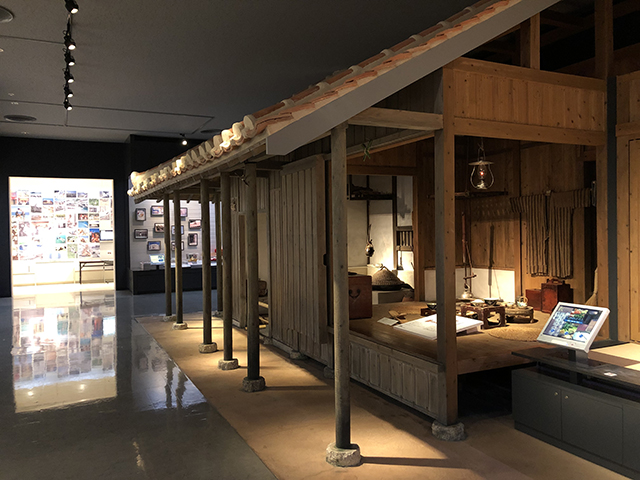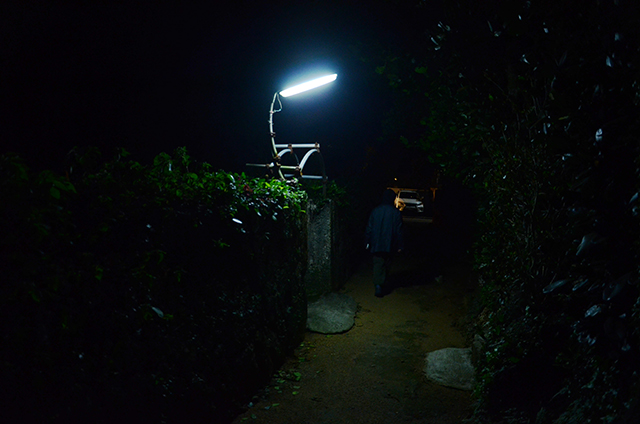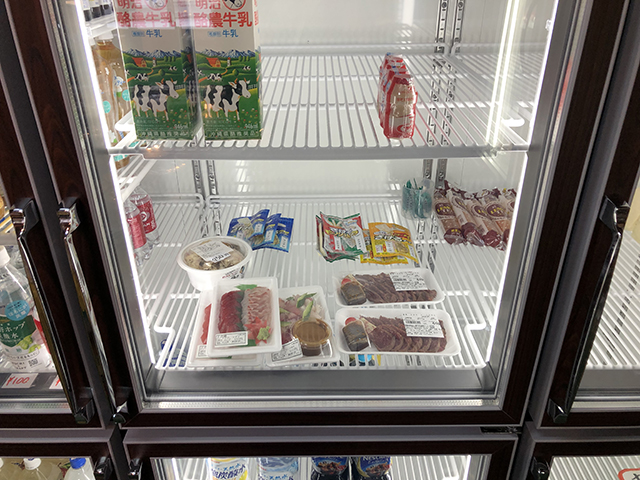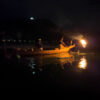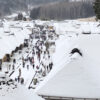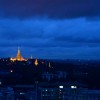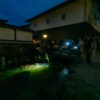2023.01.26-01.29 Masafumi Yamamoto + Yuki Ito
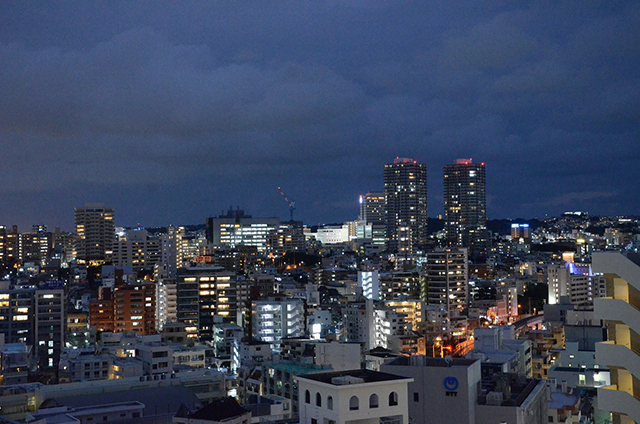
You can see a mixture of concrete buildings unique to Okinawa and high-rise residential buildings that were probably built in recent years.
Okinawa is a place where diverse cultures and histories are intertwined. In Okinawa, each region has its own unique streetscape, and this is due to the fact that each region has a completely different historical background. The following is a simplified explanation of the historical background of each area. The Naha area was severely damaged in the war and was rebuilt; the Koza area was influenced by the U.S. military base and retains a strong American culture; and the Bise and Imadomari areas retain the traditional streets of the Ryukyu Islands. By comparing the light environment of each area, this survey sought to determine what kind of lifestyle culture and light features each area has, and what kind of light is unique to Okinawa.
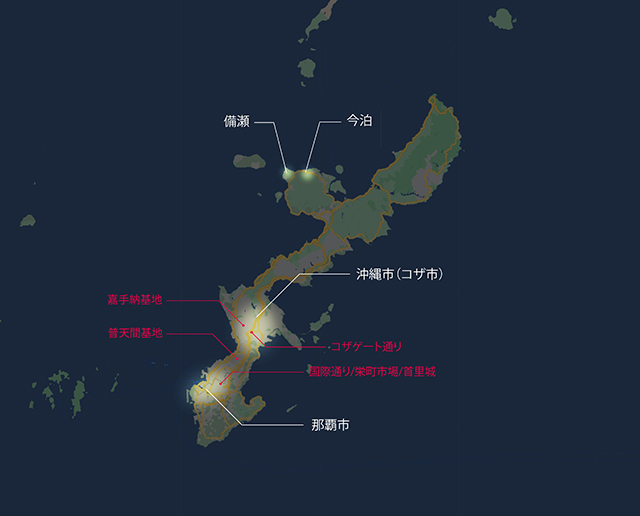
■Sakae-machi Market
Sakae-machi Market, located in Naha City, is a shopping street that was established during the postwar reconstruction period and has remained almost unchanged since then. Today, the market is a lively place where locals gather during the daytime, but at night it transforms into a more local haunt, drinking district that is quite different from the impression it gives during the daytime. The only light at night is from the taverns and the faint fluorescent lights in the upper part of the shopping street. (Floor illumination: approx. 20 lx) The illuminance alone gives the impression of dimness, but the actual atmosphere was not as dark as the impression given by the illuminance. I wondered why, and I think it may have something to do with the local residents. The locals extended their seats outside the stores and held parties, and their lively voices spread throughout the entire shopping district. Perhaps this is why the atmosphere of Sakae-machi Market gave me a completely different impression from that of the light
evaluation, even though the space was dark in terms of illumination.
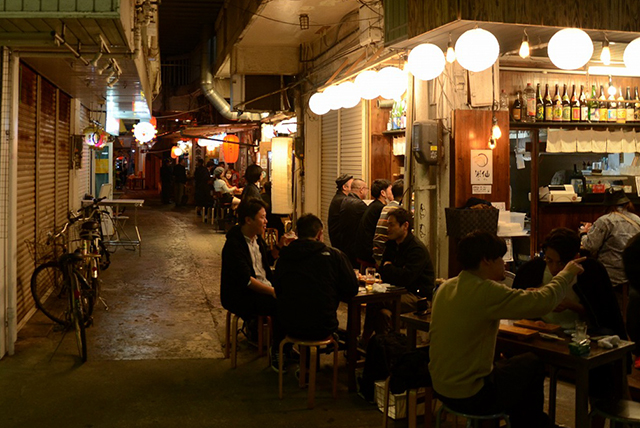
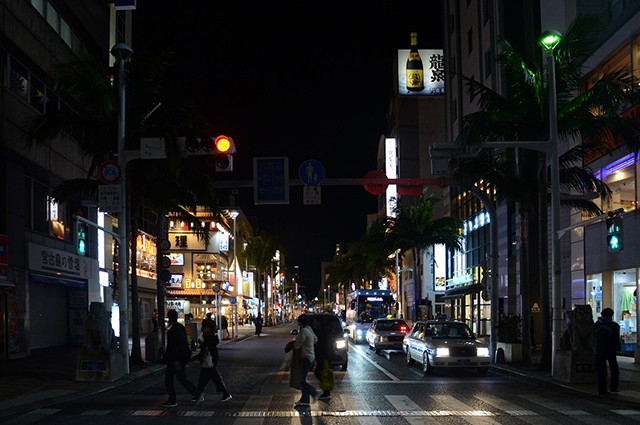
■Kokusai-dori Street
Kokusai-dori Street is crowded with tourists and lit up with twinkling lights. Many people must think of Kokusai-dori when they think of Okinawa. The lighting environment is an intense mixture of piercing light from electronic billboards and tivoli lights attached to facades. Some of the streetlights were lit green in places, perhaps due to deterioration over time. The uniformity of illumination and color temperature is also disorderly (50 to 400 lx, 2700 to 4800 K). The space was a mixture of various light elements, including a convenience store that used 2700K light, which is rarely seen even in Tokyo. It could be said that the light environment is not unified, but it is a glittering spectacle not often seen on the island of Okinawa, where people are attracted by the glittering light, and it may be one of the most representative views of Okinawa today.
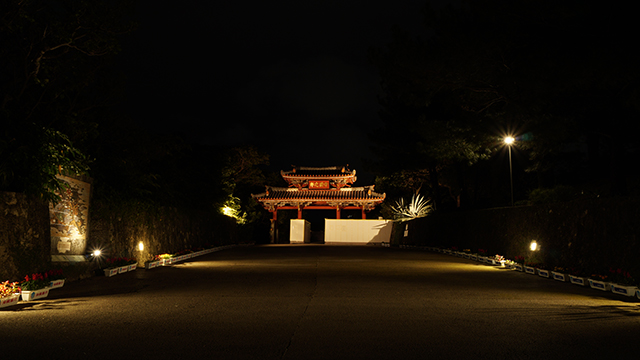
■Nightscape
It is said that 90% of buildings in Okinawa are constructed of concrete to prevent damage from typhoons and termites. With such a background, expectations were high for what the nightscape of Okinawa would be like. In reality, however, many high-rise residential buildings built in recent years were lit up, and the concrete houses and red-tile roofed houses that are representative of Okinawa were not noticeable. To be honest, the nightscape was not much different from that of other cities, which was disappointing because we had expected to see a more Okinawan cityscape. Yet, we were able to see our image of Okinawan housing from Shurijo Castle. This view of flat-roofed concrete houses was exactly what we had imagined. Unfortunately, we were not able to photograph this view at night, but we wonder how these houses are lit up here during the night.
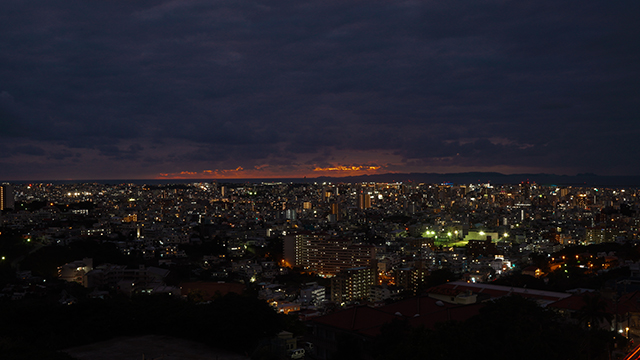
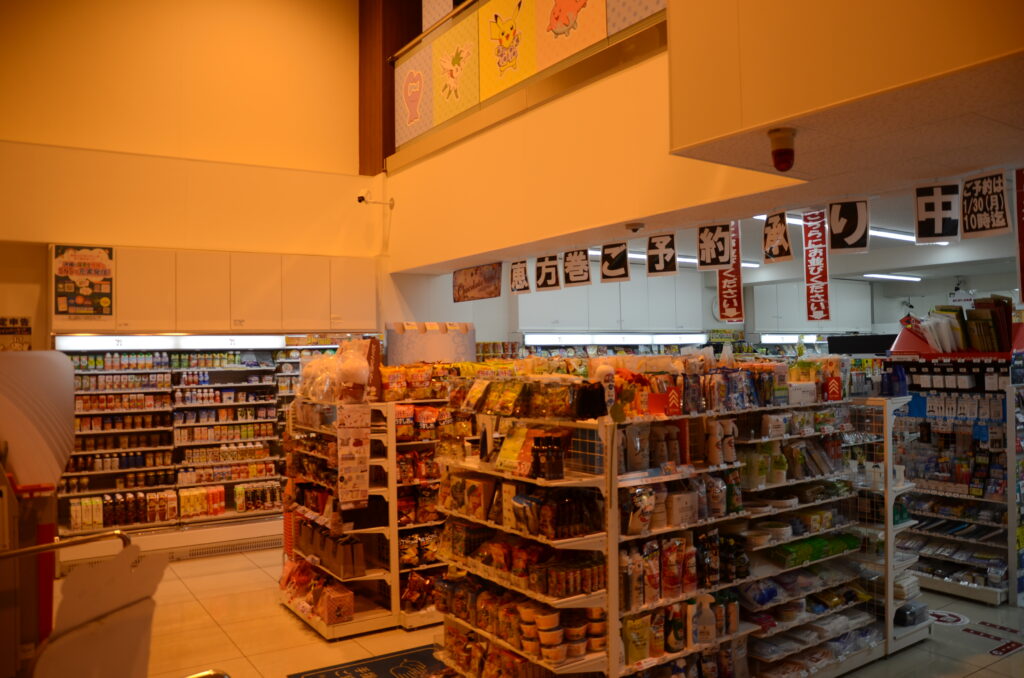
■ 2700K Convenience Store
We encountered a strange lighting environment at a convenience store located on Kokusai-dori Avenue. The convenience store uses lighting of different color temperatures in different areas, with the area facing Kokusai-dori lit by light bulb-colored lights, and white lights in the back of the store. Whether the light bulbs were installed outside in consideration of light leaking outside at night, or whether there was a mistake in the order and they had to install lights of different color temperatures not on purpose, the original intention remains a mystery…
■Shuri Castle
Shuri Castle, a symbol of Okinawa’s history and a source of emotional support for local residents, suffered an accident in 2019 when the main hall and nine other facilities were destroyed by fire. As if to cheer up the residents in the dark, the Shureimon and Kankaimon gates were quietly lit up, and the Shureimon and Huaiimon gates were lit up in the dark, as if to cheer up the residents in the dark.
Although not as powerful as the main shrine, their quiet appearance was a soothing sight. Bollard lights with a low luminance surface lined the grounds, and some residents went jogging at night. I longed to see the main shrine, which was supposed to be visible in the back, lit up strongly again someday.
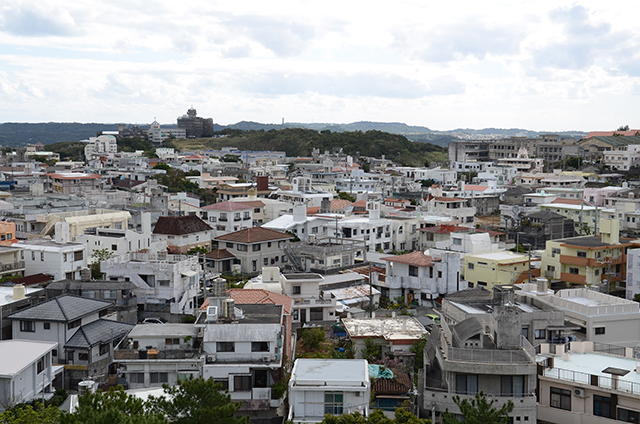
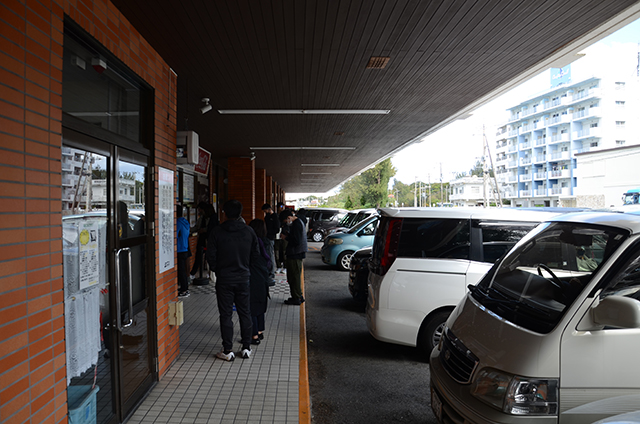
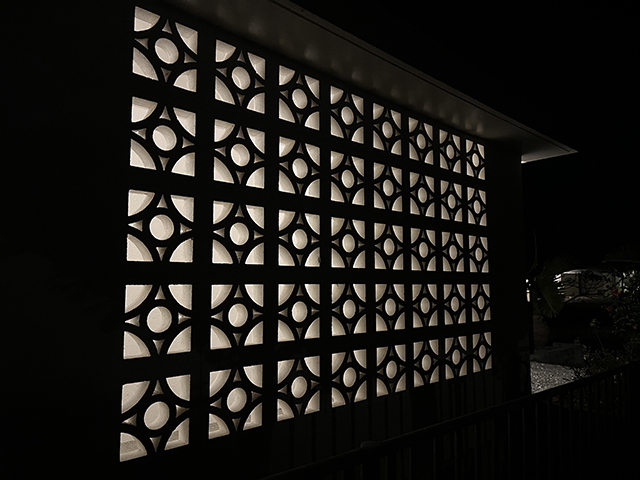
■How to deal with the strong sunlight
As mentioned earlier, Okinawa has a variety of nighttime scenes. Some places, such as Kokusai-dori Street, are brightly lit and bustling with people, while others, such as Sakae-machi Market, are dimly lit and exude a deep atmosphere. On the other hand, however, the daytime expression of Okinawa is uniform. During the daytime, strong sunlight pours down uniformly in all areas, illuminating the land of Okinawa. Therefore, measures to cope with the strong sunlight can be seen everywhere in Okinawa. Among them, flower blocks are a symbol of Okinawa.
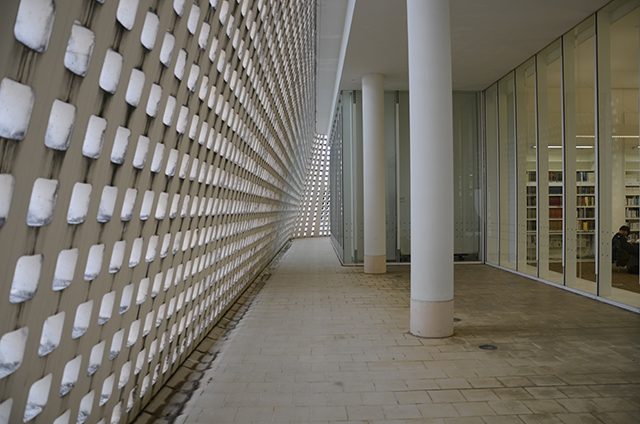
The flower blocks are designed not only to block strong sunlight, but also to allow soft light and breezes in through the gaps between the blocks. During the day, the shadows cast by the sunlight color the interior, and at night, the light from inside the building makes the flower blocks appear as silhouettes. In addition, the eaves of one building are designed to be much longer than the ceiling height to prevent the sunlight from reaching inside, and in the shopping area, tarps are always installed to softly diffuse the strong sunlight. (Yuki Ito)
■Futenma Airfield
When I thought I heard a roar from overhead, two fighter jets flew side by side. The presence of the base is familiar to us, as 70% of the main island is occupied by U.S. military facilities. Looking at Futenma Air Station from Kakazudaka-dai Park, the scale of the airfield adjacent to a residential area is overwhelming. As the sun sets, the runway approach lights and taxiway lights twinkle in the darkness as if they are weaving through the darkness of the city. The base facilities beside the runway are lit by sodium
lamps over a wide area, which do not blend in with the 4000K to 5000K cityscape of the surrounding residential areas.
It does not blend in with the 4000K to 5000K streetscape of the surrounding residential neighborhoods. It separates the two light environments like a border line laid out on the asphalt in front of the gate. The appearance of such light contours in various parts of the island is a scene unique to the base town.
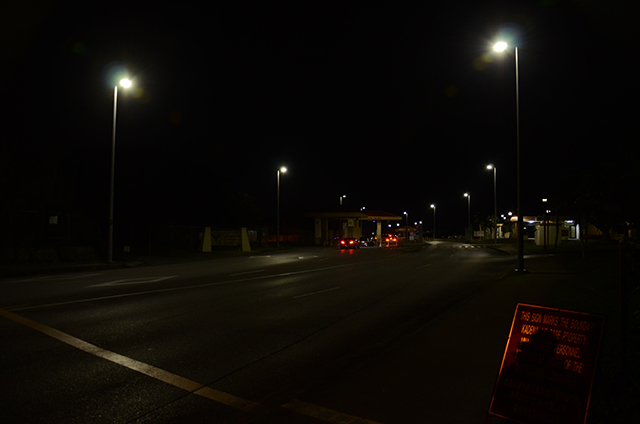
■U.S. Military House
From the high ground, a bird’s-eye view of the base house reveals a row of neatly lined buildings illuminated by 4000K pole lamps that look like an island. When you get close enough to see through the barbed wire, you can clearly see the light from the windows of the houses. They were all the color of light bulbs. Some of the homes had flickering lights around the windows, and through the curtains I could imagine the residents relaxing in their living rooms. In any environment, homes should be illuminated to provide a sense of peace and relaxation, free from tension. Above all, they must be more familiar with the color of light bulbs than the Japanese.
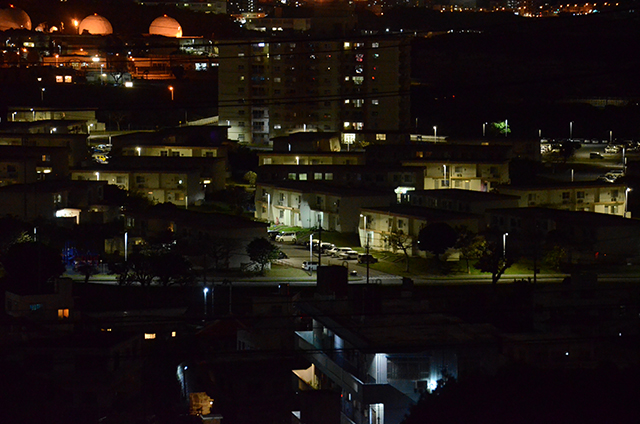
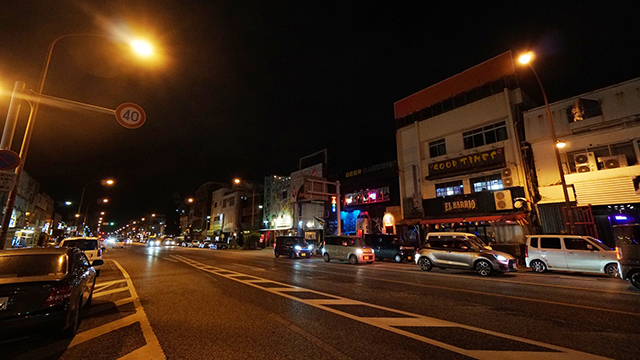
■Koza Gate Street
The main street leading from in front of the gate of Kadena Air Base is full of exoticism. The roadway is lit by sodium lamps and the sidewalks are white. However, the lights that stand out on the street are the store lights along the street. Neon lights and signs twinkle, and even the flickering lights of traffic lights are in sync with them. Indirect red and green lighting floats suspiciously in front of stores, and foreign nationals chat with each other at bar counters. These scenes continue on both sides of the street. The buildings are all about three stories high. The dazzling facade lighting that seems to dominate the night on the main street is generous and liberating, unlike the orderly light environment of the base. However, right next to the base, there is a residential area unique to Okinawa with concrete structures and water tanks on the rooftop, and Ryukyu-style residences scattered about, with the night streets illuminated by white street lights. Of course, many of the windows of the houses are also white. Away from the hustle and bustle of the exotic downtown area, the quiet and inorganic lights of the streets make you feel at ease, even welcomed by the unique lights of Japan. From a slightly elevated vantage point, the streets of Koza Gate Street looked like an oasis of
light that had suddenly appeared. ( Masafumi Yamamoto)
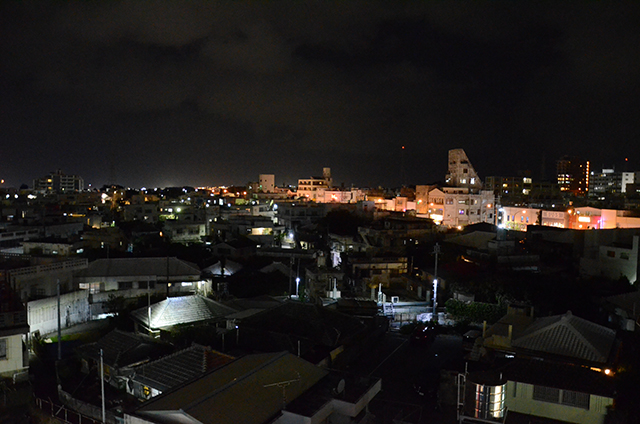

■The village of Bise
The wind blowing through the grove of Garcinia subelliptica trees shakes the trees and makes the outline of the sunlight falling through the trees on the white sand tremble slightly. Walking along the beach, the sea breezes from the shifting seas almost take away your strength, but the tree-lined paths block them and make you feel comfortable.
At night, however, the streets are so dark that you have to walk with a flashlight to feel safe. The intense environment of the seaside area also means that there are many broken appliances. Perhaps because of this, I was surprised at the brightness of lights in vending machines and public phone booths on the side of the road, which I usually do not pay attention to. Street lights are scattered at each intersection of the tree-lined
streets. An old private house restaurant, which must be visited by many tourists, illuminated Ryukyu roof tiles, and there was indirect lighting at the bottom of a sign indicating the route of the grove of Garcinia trees, which was a very small but dramatic illumination.
■Village of Imadomari
The unique Okinawan store operated jointly by villagers and selling goods necessary for daily life is called “Kyodo kiosk. We visited Moroshi Kyodo Kiosk, located on the outskirts of the village of Imadomari. According to the clerk, it is no longer operated under this system. The shop sells a full lineup of daily necessities. Come to think of it, at the market in Naha, which I visited on the first day, fresh foods were sold under high color rendering light. However, the sashimi at the public store was illuminated by a white fluorescent light. It is not necessary to go to the trouble of attracting the food to be sold. Garcinia tree is the symbol of both Bise and Imadomari, but it is not lit up at night. It is frustrating to think that if they were illuminated, the night view would be more beautiful. I gently changed the angle of the spotlight that was illuminating the ground of the Fukugi trees, and when I shone it on the trees, their large branches floated above my head.
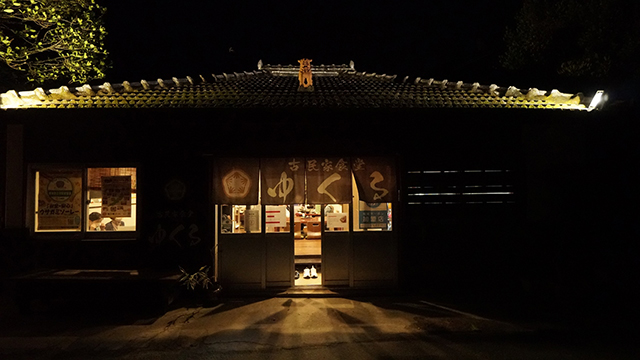
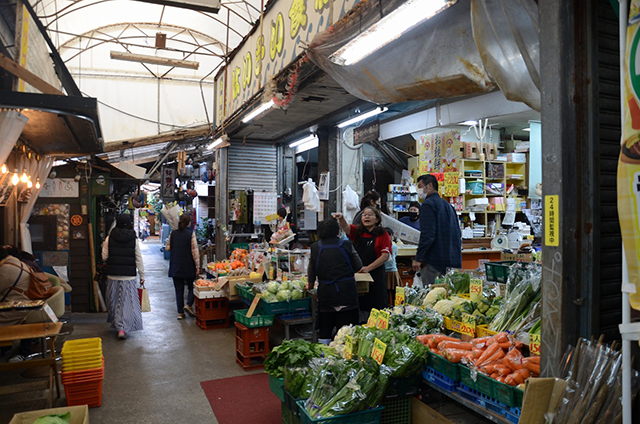
■Lifestyle and Lighting in Okinawa
The Nakamura family residence is a traditional Okinawan dwelling in its complete form, but the orderly arrangement of pendant lamps does not evoke an Okinawan atmosphere. The old private house inn where we stayed that day also had twinkling lights on the ceiling of the first room. When I explained to the innkeeper how I had traveled around the island to investigate the light environment, he showed me an oil lamp from his warehouse.
I found a diorama with the lamp hanging from it at the Okinawa Prefectural Museum, which I visited on my last day. I wondered if the lighting in Okinawan residences has changed with the waves of modernization, just as it has on the mainland. A cantera made of empty cans with English letters on display at the museum shows the influx of American culture and the poverty of the time. I was reminded of the words of a gallery owner I met on this trip who has lived in Okinawa since the reversion: “Inside the base was heaven, Okinawa was poor. “The lighting that supports life in this island nation living in harmony with its rich nature is unique in each of Naha, Koza, Bise, and Imadomari. The symbiosis of all these elements in one island nation forms the one and only light environment unique to Okinawa. They stand side by side in the rich and harsh natural environment and support the lives of the islanders. (Masafumi Yamamoto)
